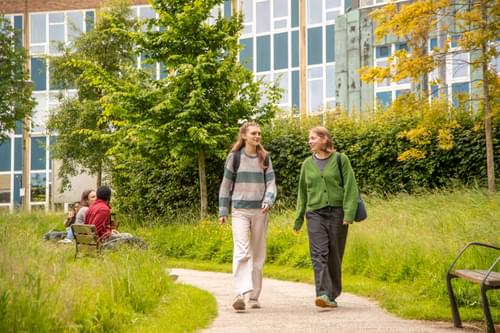Integrated Sustainable Travel Plan
Our Integrated Sustainable Travel Plan 2020-2025 sets out the key benefits for those using sustainable travel who work, live and study at the University; for the University itself; for the local community; for the local economy and for the environment. These are the three pillars of sustainability and throughout the ISTP we refer to the three most relevant Sustainable Development Goals (SDGs) Good Health and Well-Being (SDG3), Sustainable Cities and Communities (SDG11) and of course, Climate Action (SDG13).
The ISTP notes that we “need to play a strong part in assisting to reduce congestion and air pollution and improve air quality, cycling and pedestrian safety for our students, employees and local residents in and around Durham City. Therefore, it is in the interests of all our employees, students, the University and Durham City, that we will aim to do what we can to help people out of their cars wherever possible: to walk, cycle or use public transport whenever feasible.
Targets
The ISTP also includes a set of aims, objectives and actions, delivered and designed by the University, to encourage and enable sustainable travel for employees, students and visitors to aid achievement of its targets.
Section 8 of the ISTP outlines targets for sustainable commuting and visitor travel, including minimising single-occupancy car journeys and increasing journeys made using public transport, cycling, walking, and parking and riding against a 2019 baseline. Annual travel surveys to both employees are used to support this monitoring.
The ISTP also lays out targets to reduce business travel emissions as well as to reduce the carbon impact of services and deliveries to the University.
Management and Governance
The Integrated Sustainable Travel Plan Steering Group provides the management support required to take forward the strategic decisions of the University relating to travel Planning, including contributing to the establishment of the Integrated Sustainable Travel Plan 2020-2025.
Progress on targets around active and sustainable travel is reported to the University’s Environmental Sustainability Strategic Planning Group (ESSPG).
Travel Information
Information detailing sustainable travel options including walking and cycling and public transport for commuting to, and travel around the University and Durham City, are available on our Travel information website.
Monitoring
The University measures the impact of much of our travel and reports some of this as part of our partial Scope 3 emissions in our annual report and to HESA – this includes Carbon emissions data arising from our fleet and from our Business Travel.
As well as these means, we measure the impact of staff and student commuting, including through annual surveys. This year we participated in a project on staff commuting to get granular detail by working with the North East Combined Authority. This showed that the Average Commuter Emissions Level (ACEL) is 571, which equates to an average of 571 kg CO2e per employee per year through commuting behaviour and the average distance commuted one-way being 14.4 miles.
This data enables us to set ambitious and meaningful targets for more sustainable commuting, including by walking, cycling, car sharing, electric vehicles, and public transport. We are currently drafting our refreshed Integrated Sustainable Travel Plan which will be adopted in January 2026 to run for the next five years. This will outline actions as well as targets for staff, student and wider community travel to and from the University as well as travel undertaken between sites and business travel.


/prod01/prodbucket01/media/durham-university-business-school/study/dba/Home-Page-Banner-or-Footer.png)
